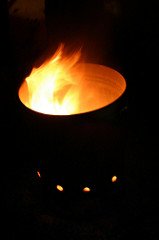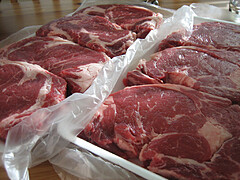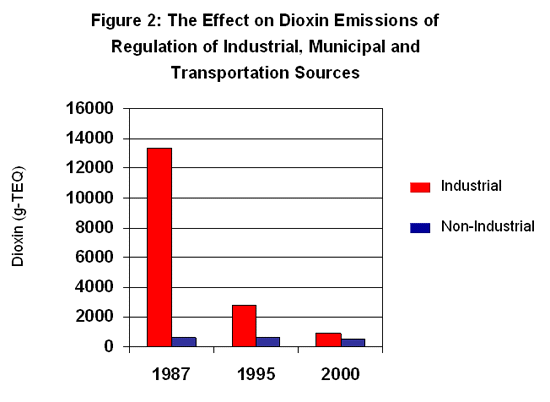|
|
The chemical name for dioxin is 2,3,7,8- tetrachlorodibenzo para dioxin (TCDD). The name "dioxins" is often used for the family of structurally and chemically related chlorinated dibenzo para dioxins (CDDs, including polychlorinated dibenzo para dioxins, or PCDDs) and polychlorinated dibenzofurans (PCDFs). Certain dioxin-like polychlorinated biphenyls (PCBs) with similar toxic properties are also included under the term “dioxins.” More than 400 types of dioxin-related compounds have been identified, but only about 30 of these are considered to have significant toxicity, with TCDD being the most toxic.1
Dioxins are persistent organic pollutants (POPs), meaning they do not easily break down in the environment.2 CDDs are produced by human activities but also known to occur naturally as a product of incomplete combustion of organic material by forest fires or volcanic activity. CDDs are not intentionally manufactured by industry, except in small amounts for research purposes. CDD emissions associated with incineration and combustion activities are the primary environmental source.3
Chemical and Biological Properties
| Number of Chlorine Atoms | Chemical Name |
|---|---|
| 1 | mono-chlorinated dioxin |
| 2 | dichlorinated dioxin (DCDD) |
| 3 | tri-chlorinated dioxin(TrCDD) |
| 4 | tetra-chlorinated dioxin (TCDD) |
| 5 | pentachlorinated dioxin (PeCDD) |
| 6 | hexa-chlorinated dioxin (HxCDD) |
| 7 | hepta-chlorinated dioxin (HpCDD) |
| 8 | octa-chlorinated dioxin (OCDD) |
The Chlorinated Dibenzo Dioxin (CDD) family includes 75 chemicals divided into eight groups based on the number of chlorine atoms in the compound, as shown in the table.4 2,3,7,8-TCDD (TCDD) is one of the most toxic and extensively studied of the CDDs and serves as a prototype for the toxicologically relevant or "dioxin-like" CDDs. Thus we focus on 2,3,7,8-TCDD here. 
TCDD is a by-product formed during the manufacture of 2,4,5-trichlorophenol (2,4,5-TCP). In the pure form, CDDs are colorless solids or crystals. CDDs enter the environment as mixtures containing a variety of individual components and impurities.5
2,4,5-TCP was used to produce hexachlorophene (used to kill bacteria) and the herbicide, 2,4,5-trichlorophenoxyacetic acid (2,4,5-T). Various formulations of 2,4,5-T have been used extensively for weed control on crops and range lands, and along roadways throughout the world. 2,4,5-T was a component of Agent Orange, which was used extensively by the US military in the Vietnam War.6
Dioxins accrue in fat tissue and bioaccumulate in the food chain. Being highly lipophilic, dioxins dissolve in fat, where they can be stored for long periods. To be excreted from the body, they must first be metabolized in the liver to become water soluble. However, dioxins are metabolized slowly and therefore tend to accumulate in fat and in the liver. The speed of elimination of dioxins can vary with dose, quantity of body fat, age and sex. The process of elimination of dioxins and PCBs is similar in animals and humans, but it is faster in most other mammals.7 The half-life of dioxins in the body is thought to be 7 to 11 years.8
Although dioxin (2,3,7,8-TCDD) was first recognized as toxic for its effects on chemical industry workers in the late 19th century, it was not declared a probable human carcinogen by the US Environmental Protection Agency (EPA) until 1985. The International Agency for Research on Cancer (IARC) classified dioxin as "carcinogenic to humans" in 1997, and in 2001 the US National Toxicology Program also classified dioxin as a known human carcinogen.9
Health Effects
Dioxins, especially TCDD, are considered highly toxic; they are carcinogenic and can damage the immune, reproductive, and developmental systems, especially by interfering with hormone activity.10 The European Union prioritization list categorizes TCDD as an endocrine disrupting chemical. Data from animal models suggest TCDD is linked to endometriosis, developmental and neurobehavioral effects, developmental reproductive effects, and immunotoxic effects.
Acute dioxin exposure (TCDD) can cause chloracne, redness and pain.11
Vulnerable populations
The developing fetus and newborn, with rapidly developing organ systems, may also be most vulnerable to certain effects of exposure. Some individuals or groups of individuals may be exposed to higher levels of dioxins:
- high consumers of fish
- workers in the pulp and paper industry, in incineration plants and at hazardous waste sites, and other industries that involve processes that produce dioxins).12
Exposures
Dioxins can be absorbed into the body by inhalation of dust, through the skin and by ingestion.13
Diet is the primary source for human exposure to dioxins, primarily through animal fats in meat and dairy products. Human breast milk is unfortunately a contaminated food source, and breastfed infants may have a daily intake of dioxins per pound of body weight 10 to 100 times greater than for adults.14 Even though breast milk is contaminated with dioxins and other toxicants, breast milk contains many nutrients and other components highly beneficial to babies, and breastfeeding is recommended for infants for at least six months by the World Health Organization (WHO),15 the American Academy of Pediatrics,16 and the US Centers for Disease Control and Prevention.17
CDDs also have been detected at low concentrations in cigarette smoke, home heating systems, and exhaust from vehicles running on gasoline (either leaded or unleaded) or diesel fuel. Dioxins may be formed during chlorine bleaching of pulp and paper. CDDs can be produced through burning many materials that may contain chlorine, such as plastics, wood treated with pentachlorophenol (PCP), pesticide-treated wastes, other polychlorinated chemicals (polychlorinated biphenyls or PCBs), and even bleached paper.18
Reducing Exposures
|
|
Reducing exposure occurs at both the individual and community level. Individuals can take these actions to reduce exposures at home:
- Trim excess fat from meat
- Consume dairy products lower in fat
- Eat a balanced diet, including plenty of vegetables, plus fruits and whole grains. A diverse diet will help to avoid excessive exposure from a single source.19
Community and industrial action for preventing and controlling exposure to dioxins involves proper incineration of contaminated material.
Regulation
Overall, industrial, municipal and transportation dioxin emissions have declined dramatically as a result of regulation, whereas emissions from backyard barrel burning of rubbish and residential wood burning have remained essentially constant since 1987.20
|
"Dioxin" here is defined as the totality of 7 dioxins and 10 furans. "TEQ" denotes "toxic equivalent," a quantitative measure of the combined toxicity of a mixture of dioxin-like chemicals. Source: Toxipedia with data from US EPA21 |
WHO's periodic studies on levels of dioxins in human milk provide an assessment of human exposure to dioxins from all sources. Recent exposure data indicate that measures introduced to control dioxin release in a number of developed countries have resulted in a substantial reduction in exposure over the past two decades.22
Though governments and industry have taken measures to reduce dioxins’ integration into the environment, their persistence in the environment and in the food chain mean that continued oversight and regulation will be needed for a long time.
The Joint FAO/WHO Expert Committee on Food Additives (JECFA) performed an updated comprehensive risk assessment of PCDDs, PCDFs, and “dioxin-like” PCBs in 2001. The experts established a provisional tolerable monthly intake (PTMI) of 70 picogram/kg per month. This level is the amount of dioxins that can be ingested over a lifetime without detectable health effects.23
EPA's National Primary Drinking Water Regulations Maximum Contaminant Level for 2,3,7,8-TCDD is 0.00000003 mg/L, or 3 parts per 100 trillion.24
This page's content was created by Lorelei Walker, PhD, and Nancy Hepp, based on content from Toxipedia, and last revised in August 2016.
CHE invites our partners to submit corrections and clarifications to this page. Please include links to research to support your submissions through the comment form on our Contact page.
![]()
The information on this page is adapted from toxipedia.org. To learn more about Toxipedia’s integration into our website, visit our Toxipedia webpage.




